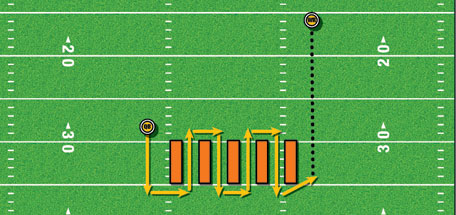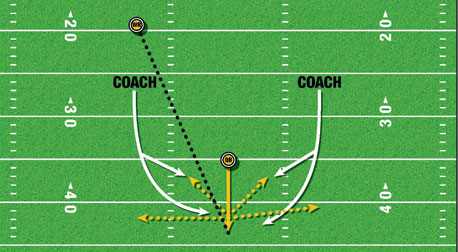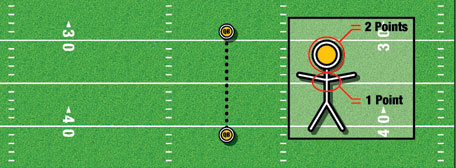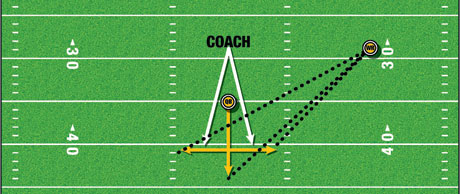AMERICAN FOOTBALL MONTHLY THE #1 RESOURCE FOR FOOTBALL COACHES
Article CategoriesAFM Magazine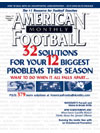
|
The Drills Report: Advanced Quarterback Drillsby: Jeff HancockOffensive Coordinator/QB Coach, Adrian College © More from this issue As with many offenses in this day and age we run a spread out of many different personnel packages and motions. Unlike most offenses, we use the “Gun” exclusively because it fits our personnel best. The problem with this is that quarterbacks left to their own devices in the gun will start to develop bad habits, mainly throwing mechanics. For example, a QB who always throws out of the gun will start to develop lazy feet, bad body positioning, and not getting his shoulders in proper position. To combat this we do “every day drills” like most coaches. The thing that would surprise most who would watch us practice after seeing us play is that our every day drills are almost all run from under center. This is to ensure that our QB’s don’t lose their proper technique. One of the things that we did to ensure very little time was wasted in practice, especially early in fall camp, was to make a drill book with an instructional tape to show all QB’s each drill that they would be practicing. The purpose and coaching points were also included for each drill. Before we teach anything else, we teach our drills. All drills fit into our offense and focus on individual aspects of certain plays or specific things that a quarterback may be having trouble with. This drill book consists of roughly 15 drills that we do every day and another 15 or so that we do at least once a week. The following drills are a selection of drills that we do every day. Drop & Weave Drill
The goal of this drill is to get the QB to keep his feet moving and to keep the ball in the “loaded” position while weaving in and out of pressure. He keeps his shoulders perpendicular to the line of scrimmage with eyes looking down field “feeling” the bags as he works through them. To start, we line up five ground bags with about a foot between each. We have a QB start at the front of the bags on one end, take a 3 or 5 step drop as if under center. As the QB works through the bags using the proper techniques explained above, a Coach will stand 10 to 15 yards down field and hold up different fingers so the QB must look down field and call out the number of fingers held up to ensure that his eyes are where they should be. While the QB steps up field going through the bags, he must shuffle his feet so as not to cross over. When through the bags, the QB steps up and throws the ball to a WR standing down field. Once all QB’s have gone through the drill in one direction, have them go over to the other side and weave through in the other direction. Drop & Step Up Drill
This is another drill involving ground bags but this time the purpose is to simulate pressure from just one side. Line up three to five bags in a diagonal with about a foot between them. The number of bags will be determined by what type of drop you are working on. Here the QB will take his drop as if from under center. He will then side step and run through as he works back towards the line of scrimmage. Once through he will get his shoulders turned accordingly to throw to the WR down field. Again, as with the last drill, a coach will stand down field and hold up fingers to ensure the QB is looking downfield and “feeling” the bags as he calls out the number of fingers being held up. Once all QB’s have gone through in one direction, flip the bags so they can go through in the other direction. Now the QB must lift his feet to step over the bags to simulate bodies on the ground. Drop & Pressure Drill
This drill doesn’t use ground bags but will need a coach and a few available QB’s. Get a QB in position to take a drop as if under center. Have two other QB’s stand in the positions of DE’s. The coach stands behind the QB and tells each “DE” whether he wants them to run up field or merge inside. The coach then gives the verbal key, the QB takes his drop, the “DE’s” come on the path given and the QB must avoid pressure while working on the fundamental aspects of a proper drop. The QB will side step or step up and deliver the ball to the WR standing down field. “10” Drill
This drill is a competitive way to get QBs to work on accuracy. The easiest way for us to run this drill is to partner up all QBs, have them stand 10 yards apart, and instead of just playing catch they are trying to hit a target. If the ball hits in the head region, they are awarded 2 points. If the ball hits in the chest area, they receive 1 point. When the quarterback throws he must have his shoulders perpendicular to the target, feet shoulder width apart, and as he throws, shift his weight from slightly back to forward and follow through. The first quarterback to 10 points wins that round. You can move your QB’s around any where you would like for this drill. Have them further apart, off set them, or have them take a drop and throw at different distances. Rapid Fire Drill
This is one of the few drills we use that allows the QB to line up in the “Gun.” The coaching point of this drill is to get the QB to find the laces of the football quickly and throw it. It works best if the WR lines up in a position of running a swing (bubble) route. This forces the QB to also “flip” his hips to throw and get them back quickly to get the next ball snapped. The QB will line up in a “ready” position to catch the snap. The coach will get on a knee with 8-10 footballs. On the QB’s cadence, the coach snaps the first football to the QB. As the QB throws the first football, the coach snaps the next one to force the QB to get his body back in position to get the next snap. This will continue until all footballs have been thrown. The next time the WR is repositioned so that the quarterback has to throw in a different direction. Again, the best position for the WR in this drill is off to the right for a right-handed QB and vice versa for a lefty. The QB continuously works on getting his hips flipped to throw and getting them back for the next snap. This drill should, over time, help eliminate the time it takes for a QB to get to the laces and throw on time. Duck & Throw Drill
This final drill is another “avoiding pressure by feel drill.” Align a quarterback so he is in position to take a snap from under center. Put another QB back behind him at about 8 yards. The coach will then stand in front of the QB with a Nerf football. As the QB takes his drop, the coach throws the Nerf football so that the QB, while in his drop, has to side step the football and then deliver the ball to a WR down field. The quarterback behind him will catch the Nerf football. Coaching points for this drill are not unlike the others in regards to mechanics, but this one emphasizes the side step forward or backwards with the back foot first while continuously keeping the eyes down field. Jeff Hancock is in his fourth season at Adrian College and 15th overall. He previously coached at Grand Valley State, Louisiana Tech, and Eastern Michigan. |
|
| HOME |
MAGAZINE |
SUBSCRIBE | ONLINE COLUMNISTS | COACHING VIDEOS |
Copyright 2024, AmericanFootballMonthly.com
All Rights Reserved


